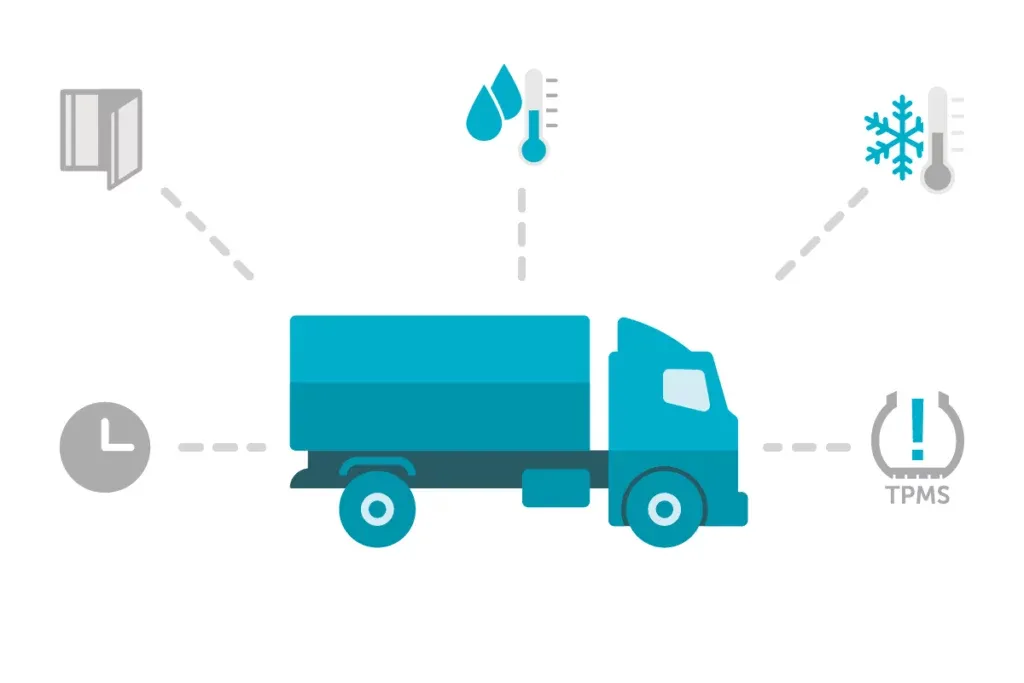Telematics systems are becoming crucial for commercial vehicle operations and are often used in tandem with various vehicle safety products. For instance, logistics and transportation companies can keep track of fleet operations using vehicle telematics. The data collected often improves efficiency through route optimisation. With rising fuel costs, telematics equipment helps businesses understand the consumption of their fleet and find ways to streamline operations.

What Is Vehicle Telematics?
A vehicle telematics system is an onboard communication application that relays information to other telematics devices and GPS receivers. That’s why logistics and transportation companies rely on telematics vehicle tracking systems to keep track of their fleets. Telematics data also helps businesses ensure smooth operations and comply with regulatory requirements like driver-hour laws.
A telematics system combines onboard vehicle diagnostics, wireless telematics devices, and GPS systems to record and transmit data. When a fleet manager installs a vehicle telematics system, it consists of fleet tracking devices and software solutions that facilitate the storage and transmission of telemetry data via wireless networks. Information transmitted from the vehicle telematics systems is sent to a data server and decoded to provide meaningful information. Most fleet management companies rely on software applications with visual indicators and reporting tools to gain business intelligence for informed decision-making.
Some collected vehicle telematics data include fuel consumption, locations and vehicle faults. The system also monitors drivers’ behaviour, including idle time, braking, sharp acceleration and speed.
How Do Vehicle Telematics Work?
Vehicle telematics follows these 3 steps:
1. Vehicle telematics device installation
A vehicle telematics system relies on a telematics device or tracker to collect and transmit data. Installing a telematics device involves plugging it into the vehicle’s onboard diagnostics port (OBDII) or the CAN-BUS port. Telematics devices usually have a SIM card and modem to transfer data via a cellular network. If the vehicle uses other types of telematics devices, the installation guide is used to fix the system to the vehicle. The device starts recording and sharing information through the cellular network shortly after installation.
2. Data collection
The fitted telematics device retrieves and records data generated from the vehicle. It collects information from the engine and stores it in the cloud. The data collected includes GPS location, vehicle faults, vehicle position, speed, distance and engine data.
3. Data decoding
A vehicle telematics system is incomplete if the fleet manager or its users cannot access the data collected. After data collection, information is transmitted to the software application or server for analysis. Most fleet companies have fleet management software that receives data from telematics systems and analyses it to determine whether a vehicle is due for maintenance or if a driver needs additional training. A vehicle telematics system employs data analytics and machine learning to extract better value from the collected vehicle data. Fleet management companies can rely on real-time information to analyse vehicle location, fleet vehicles and service delivery.
What Are the Benefits of Vehicle Telematics Solutions?
Fleet managers enjoy numerous benefits of integrating vehicle telematics. The top advantages of vehicle telematics hardware include the following:
- Visibility: Vehicle telematics data gives fleet managers visibility into the whereabouts of company trucks and vehicles by monitoring real-time movements. Since the telematics device has a GPS system, it is easy to monitor the location of vehicle fleets and track containers or other assets during the shipping process.
- Maintenance: A vehicle telematics device is plugged into the onboard diagnostics port, which gives it access to engine data. Fleet managers can monitor engine load, coolant temperature and fuel consumption. From the engine data, vehicle faults are identified, and maintenance is scheduled to ensure the vehicles are in good shape.
- Safety: The vehicle telematics system collects useful information on drivers’ behaviours, like speeding and harsh braking or acceleration. Fleets can improve safety by gaining insights into driving habits that could lead to accidents. With this data, fleet managers can provide training to improve road safety. In addition, insurance companies typically use drivers’ behavioural data to assess risk factors.
- Fuel optimisation: With vehicle telematics data, fleet managers can identify trends in route performance or driver’s actions that lead to high fuel consumption. By analysing the information, fleet operators can optimise routes and improve fuel efficiency. Since fleet managers monitor fleet routes, they can redirect them to avoid unexpected road delays or heavy traffic.
- Fleet management: Combining vehicle telematics solutions with a fleet management system can help improve the operations of logistics and transportation companies. For instance, vehicle telematics systems generate valuable insights used for decision-making. From the data, managers can improve vehicle scheduling and route optimisation for higher returns. Onboard diagnostics also save money by providing better fuel and safety management. Since you can track driving hours and rest, maintaining compliance with the duty of care obligations for driver’s hours is also easier.
Conclusion
Vehicle telematics is becoming a staple in commercial vehicular systems. As information technology infrastructure evolves and accommodates new forms of data analysis, companies can leverage vehicle telematics to improve operations. For instance, open system telematics incorporates machine learning and artificial intelligence capabilities, facilitating better data analysis. The benefits to fleet managers do not go unnoticed, with many fleet operators improving efficiency and productivity.
Sources:
Disclaimer
This content is provided for informational purposes only and is not meant to be an endorsement or representation by FleetGO.com or any other party. This information may contain inaccuracies or typographical errors, despite our efforts to ensure accuracy. FleetGO.com accepts no responsibility or liability for any errors or omissions, and is not responsible for the contents of any linked website or any link contained in a linked website. Please refer to our full disclaimer for more details.


